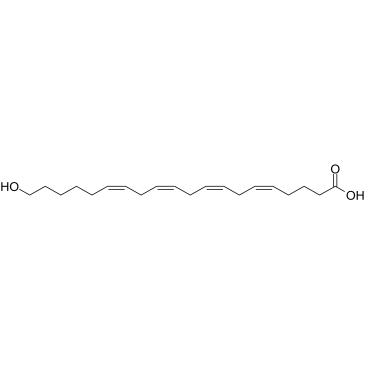20-HETE (Synonyms: 20-hydroxy Arachidonic Acid, 20-Hydroxyeicosatetraenoic Acid) |
| Catalog No.GC35075 |
Un standard analytique quantitatif garanti pour répondre aux spécifications d'identité, de pureté, de stabilité et de concentration MaxSpec®.
Products are for research use only. Not for human use. We do not sell to patients.

Cas No.: 79551-86-3
Sample solution is provided at 25 µL, 10mM.
20-HETE(20-hydroxy Arachidonic Acid) is a potent vasoconstrictor produced in vascular smooth muscle (VSM) cells. It depolarizes VSM by blocking the open-state probability of Ca2+-activated K+-channels.IC50 Value:Target: 20-Hydroxyeicosatetraenoic acid (20-HETE) is a cytochrome P450-derived arachidonic acid metabolite that has been shown to increase smooth muscle contractions and proliferation, stimulate endothelial dysfunction and activation and promote hypertension. in vitro: Addition of 20-HETE to the bath (1-100 nM), reduced the frequency of opening of the large-conductance Ca(2+)-activated K+ channel recorded using cell-attached patches on VSM [1]. In kidney, 20-HETE induces diuresis by inhibiting Na+-K+-ATPase in proximal tubules and Na+/K+/Cl+ cotransporter in the thick ascending limb of Henle's loop [2].in vivo: In Cyp4a14(-/-) mice, which display androgen-driven and 20-HETE-dependent hypertension, treatment with20-HETE antagonist abolished remodeling of renal resistance arteries measured as media thickness (24±1 vs. 15±1μm) and M/L (0.29±0.03 vs. 0.17±0.01) [4]. The transgenic mice had overexpressed hepatic CYP4F2, high hepatic 20-HETE and fasting plasma glucose levels but normal insulin level. The GP activity was increased and the cAMP/PKA-PhK-GP pathway was activated in the transgenic mice compared with wild-type mice [5]. Clinical trial: Mechanisms of Response to Diesel Exhaust in Subjects With Asthma. Phase not specified Human Endogenous Metabolite
[1]. Zou AP, Fleming JT, Falck JR, 20-HETE is an endogenous inhibitor of the large-conductance Ca(2+)-activated K+ channel in renal arterioles. Am J Physiol. 1996 Jan;270(1 Pt 2):R228-37. [2]. Schwartzman M, Ferreri NR, Carroll MA, Renal cytochrome P450-related arachidonate metabolite inhibits (Na+ + K+)ATPase. Nature. 1985 Apr 18-24;314(6012):620-2. [3]. Ding Y, Wu CC, Garcia V, 20-HETE INDUCES REMODELING OF RENAL RESISTANCE ARTERIES INDEPENDENT OF BLOOD PRESSURE ELEVATION IN HYPERTENSION. Am J Physiol Renal Physiol. 2013 Jul 3. [Epub ahead of print] [4]. Lai G, Wu J, Liu X, 20-HETE induces hyperglycemia through the cAMP/PKA-PhK-GP pathway. Mol Endocrinol. 2012 Nov;26(11):1907-16.
Average Rating: 5 (Based on Reviews and 35 reference(s) in Google Scholar.)
GLPBIO products are for RESEARCH USE ONLY. Please make sure your review or question is research based.
Required fields are marked with *




